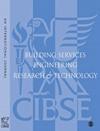脱碳的必要性
IF 1.8
4区 工程技术
Q3 CONSTRUCTION & BUILDING TECHNOLOGY
Building Services Engineering Research & Technology
Pub Date : 2021-05-01
DOI:10.1177/01436244211004788
引用次数: 0
摘要
BSER&T为本期特刊整理的论文探讨了与脱碳建筑相关的挑战和解决方案。建筑物的能源消耗约占全球温室气体排放量的四分之一。为了将全球变暖控制在1.5摄氏度以内,建筑物必须迅速脱碳。冠状病毒大流行导致2020年全球二氧化碳排放量减少约7%。这7%的减排相当于未来十年每年所需的排放量,以满足政府间气候变化专门委员会(IPCC)将全球气温上升限制在1.5摄氏度以内的目标,实现这一目标将需要全球范围内提高建筑标准和运营绩效,并对全球大多数现有建筑进行大规模改造。通过创造就业机会来实现社会和经济效益是一个巨大的机会,这将刺激全球经济,同时减缓气候变化的速度。全球经济模型一再表明,通过减少排放来减缓气候变化,比试图适应其未得到缓解的影响更便宜。经济学家大都同意,几乎不可能量化失控的气候变化带来的更广泛成本。全球气温上升3摄氏度或更高,再加上极端天气事件的数量和强度增加、海平面上升5米或更高、生物多样性广泛丧失以及大规模人口迁移,预计将导致广泛的社会崩溃。因此,不作为不是一种选择。如果要实现IPCC的碳减排轨迹,那么仅仅遵守现有的建筑标准是不够的。政府、设计师和建筑业主必须确定合适的低能耗建筑规范,以支持快速脱碳。各国政府必须修订法规,使之与所要求的减排速度保持一致。在尚未实现这一目标的地方,建筑业主不应等待政府采取行动,而应自己进行分析,建立所需的规范,并迅速实施。本文章由计算机程序翻译,如有差异,请以英文原文为准。
The need for decarbonisation
The papers collated for this special issue of BSER&T explore the challenges and solutions associated with decarbonising buildings. Energy use in buildings accounts for around a quarter of global greenhouse gas emissions. To limit global warming to 1.5 C it is essential that buildings decarbonise rapidly. The coronavirus pandemic resulted in a reduction of global CO2 emissions of approximately 7 per cent in 2020. This 7 per cent reduction in emissions is comparable to that required every year for the next decade, to meet the Intergovernmental Panel on Climate Change (IPCC) pathway to limit the global rise in temperature to 1.5 C. Achieving this goal will require global improvements in construction standards and operational performance, and the wholesale retrofit of most of our existing building stock globally. There is a huge opportunity to deliver social and economic benefits through the creation of jobs which will stimulate the global economy while slowing the rate of climate change. Global economic modelling has repeatedly shown that it is cheaper to mitigate climate change through reduced emissions, than to attempt to adapt to its unmitigated effects. Economists largely agree that it is barely possible to quantify the wider cost of runaway climate change. An increase in global temperatures by 3 C or higher combined with an increase in the number and intensity of extreme weather events, sea level rise of five metres or higher, extensive biodiversity loss, and largescale population migration, is predicted to lead to widespread societal collapse. As such, inaction is not an option. If the IPCC carbon reduction trajectory is to be achieved, then simply complying with existing building standards is not sufficient. Governments, designers and building owners must identify a suitable low energy building specification to support rapid decarbonisation. Governments must revise regulations to align with the required rate of emissions reduction. Where this has yet to happen building owners should not wait for governments to move but should undertake their own analyses to establish the required specifications and implement them rapidly.
求助全文
通过发布文献求助,成功后即可免费获取论文全文。
去求助
来源期刊

Building Services Engineering Research & Technology
工程技术-结构与建筑技术
CiteScore
4.30
自引率
5.90%
发文量
38
审稿时长
>12 weeks
期刊介绍:
Building Services Engineering Research & Technology is one of the foremost, international peer reviewed journals that publishes the highest quality original research relevant to today’s Built Environment. Published in conjunction with CIBSE, this impressive journal reports on the latest research providing you with an invaluable guide to recent developments in the field.
 求助内容:
求助内容: 应助结果提醒方式:
应助结果提醒方式:


